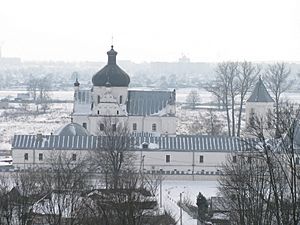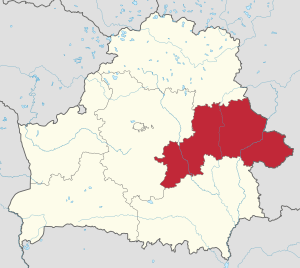Mogilev Region facts for kids
Quick facts for kids
Mahilyow Voblasts
Магілёўская во́бласць Могилёвская о́бласть
Mogilev Oblast
|
|||
|---|---|---|---|

The Saint Nicholas Monastery, Mogilev
|
|||
|
|||
 |
|||
| Administrative center | Mogilev | ||
| Largest cities | Mogilev - 365,100 Babruysk - 220,800 Asipovichy - 34,700 |
||
| Raions | 21 Towns - 14 Urban localities - 12 |
||
| City raions | 3 | ||
| Area | |||
| • Total | 29,000 km2 (11,000 sq mi) | ||
| Highest elevation | 239 m (784 ft) | ||
| Lowest elevation | 126 m (413 ft) | ||
| Population
(2009)
|
|||
| • Total | 1,099,374 | ||
| • Density | 40/km2 (100/sq mi) | ||
| Website | region.mogilev.by | ||
The Mogilev Region, also called Mahilyow Voblasts, is a large area in Belarus. It's like a province or a state. The main city and administrative center of this region is Mogilev.
The Mogilev Region, along with the Homyel Voblast, faced challenges after the Chernobyl nuclear accident in April 1986. This event caused some environmental effects in the area.
Contents
About Mogilev Region
The Mogilev Region is an important part of Belarus. It has a population of over one million people. The region covers an area of about 29,000 square kilometers.
Important Cities
Several important cities are located in the Mogilev Region. The largest city is Mogilev, which is also the capital. Other big cities include Babruysk and Asipovichy. These cities are centers for people living and working in the region.
Rivers and Nature
Many rivers flow through the Mahilyow Voblast, making its landscape beautiful. Some of the main rivers are the Dnieper, Berezina, and Sozh. Other rivers include the Druts, Pronya, and Ptsich rivers. These rivers are important for the region's environment.
How the Region is Organized
The Mogilev Region is divided into smaller parts to help manage it. It has 21 districts, which are called raions. There are also 14 towns and 12 urban-type settlements. This structure helps organize local government and services for the people living there.
Images for kids
See also
 In Spanish: Óblast de Maguilov para niños
In Spanish: Óblast de Maguilov para niños





